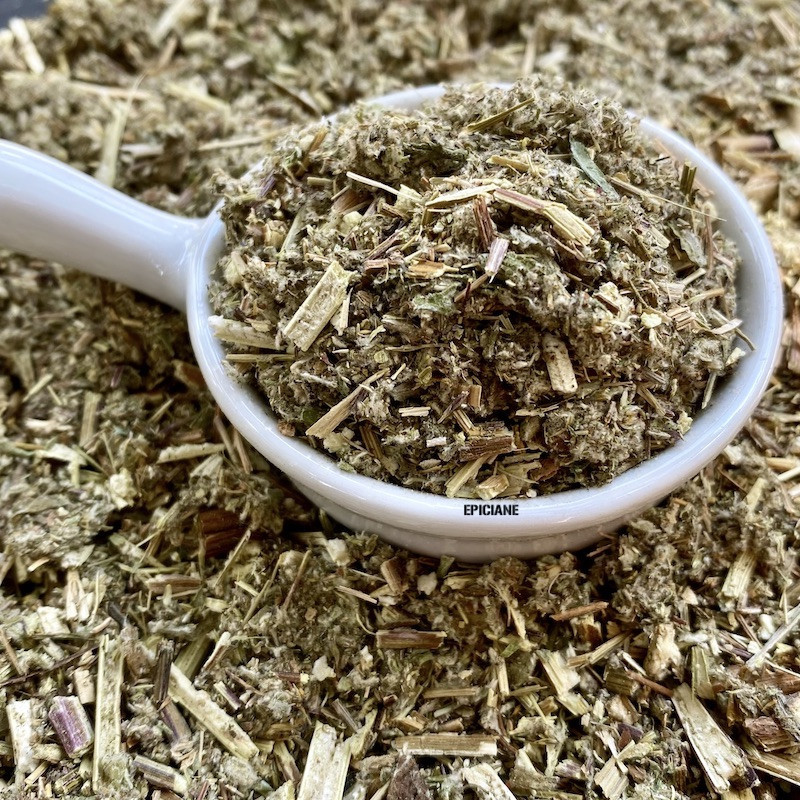
Reference: melangepoulet


Mugwort and its medicinal properties have been known since antiquity.
It also flavors many dishes and beverages, including certain beers.
 Delivery
Delivery
Mondial Relay
 Returns
Returns
See conditions
 Payments
Payments
100% secure
Livré en sachet refermable
- Plante sauvage, sans traitements, sans OGM, sans ionisation -
- Récolte manuelle, sans irrigation, séchage à l'air libre -
Pour info, 100g non tassés ont un volume d'environ 1/2 litre
Uses in Cooking and Beyond:
Here, the cut aerial parts of mugwort are utilized.
Mugwort has a flavor that is both slightly bitter and somewhat sweet, making it quite interesting for culinary uses. When dried, as it is here, it can flavor:
Fresh, its tender leaves are used in salads, and in China, its crunchy stems are a seasonal vegetable used in meat stir-fries.
Traditional medicine employs mugwort (like its cousin wormwood) primarily in infusions for its valuable properties, especially for women. The plant also contains insect-repelling compounds released into the atmosphere when burned, effective in keeping mosquitoes at bay.
It should always be used in moderation, as excessive consumption, like with its cousin wormwood, can lead to digestive issues.
Who Am I?
Origin: Albania, Diber region
Scientific Name: Artemisia vulgaris
Common Names: Common mugwort, scented mugwort, vulgar mugwort, artemisia, Saint John's belt, Saint John's crown, herb of a hundred tastes, fire herb, royal herb, Saint Peter's tobacco.
Mugwort is a herbaceous plant belonging to the Asteraceae (or Composite) family, commonly found in temperate regions and sometimes used as an ornamental plant for its finely dissected foliage. Related to tarragon, common mugwort can grow between 60 cm to 2 meters tall, with upright stems and green leaves on top and cottony silver-white undersides, releasing an odor similar to wormwood when crushed. The flowers, which bloom from July to October, are yellowish or purplish and emit a rather strong fragrance.
You can find it primarily along paths and roadsides, and in dry, sunny wasteland. It thrives in nitrogen-rich soils and can withstand winter temperatures as low as -15°C. Within the same population, there are significant variations in leaf shape and the volatile substances emitted.
Originally, the plant grew in temperate zones of Central Europe, North Africa, and parts of Asia, but it has since been introduced to many other regions worldwide.
A Little History:
Some of its medicinal properties have been known since antiquity, and the Aztecs used it for religious rituals and certain medicinal virtues. It has also been used in traditional Chinese medicine for thousands of years.
Data sheet
Reference: melangepoulet
Reference: 11N7866301
Reference: angelique
Reference: 6L5609803
Reference: 7K4954201
Reference: 6N7456401
Reference: gentiane
Reference: PL-EK0-07
Reference: aubepinefl
Reference: 9K5061101
Reference: 3N7201902
Reference: 20731803
Reference: 6K4878201
Reference: 9N7669901
Reference: 408164502
Reference: 11N7866301
Reference: angelique
Reference: 121320001
Reference: laurierE

Mugwort and its medicinal properties have been known since antiquity.
It also flavors many dishes and beverages, including certain beers.